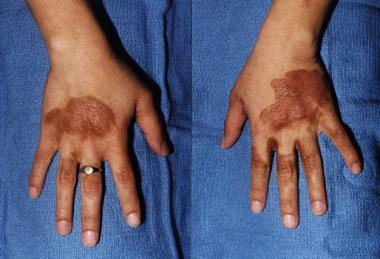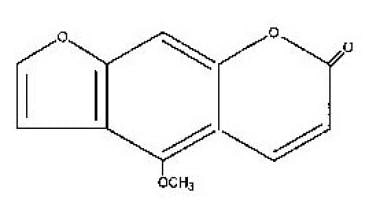Background
Berloque dermatitis is a phototoxic reaction induced by exposure to long-wave ultraviolet (UV) A (UV-A) radiation in the presence of bergapten (5-methoxypsoralen [5-MOP]), a furanocoumarin (furocoumarin) found in bergamot oil. Bergapten is the photoactive component of bergamot oil, which comes from the rind of the bergamot lime (Citrus bergamia) and has been a popular ingredient in perfumes and fragrances. The combined exposure to UVA and to bergapten induces an intensification of melanogenesis and hyperpigmentation (see the image below).
Berloque dermatitis obtains its name from the French word berloque (German Berlock), meaning trinket or charm. Rosenthal coined the term in 1925 to describe pendantlike streaks of pigmentation on the neck, face, arms, or trunk. He suspected that they were due to fluid droplets, unaware that Freund in 1916 had described hyperpigmented macules due to sun exposure after the application of eau de cologne.
The phototoxic ingredient causing the pigmentation proved to be bergapten. Several cases were reported in the 1950s and 1960s following wider use of perfumes containing oil of bergamot and increased enthusiasm for sunbathing. Since the introduction of artificial oil of bergamot and the reduced use of the natural product in perfumes, berloque dermatitis has become rare.
Avoidance of the offending compound is the primary goal of treatment. If hyperpigmentation persists, hydroquinone is used. Laser therapy may be recommended for postinflammatroy hyperpigmentation, including berloque dermatitis. [1]
Pathophysiology
Phototoxicity or photoirritation is a chemically induced nonimmunologic acute skin irritation induced by exposure to light (usually within the UV-A spectrum, 320-400 nm). [2] The skin response resembles exaggerated sunburn and requires no prior sensitization; it can be caused by a single simultaneous exposure to the chemical and the light source. The photoactive chemical may enter the skin via topical administration or via ingestion, inhalation, or parenteral administration. The reaction can be evoked in all subjects as long as the concentration of the chemical and the dose of light are sufficient.
In the case of berloque dermatitis, the phototoxic reaction is induced by the effect of long-wave UV-A radiation on bergapten (5-MOP; see the image below), which is known to be the only photoactive component of bergamot oil. The combination of bergapten and UV-A induces an intensification of melanogenesis and a corresponding increase in the number of functional melanocytes, which are more dendritic and dopa-positive. The distribution of melanosomes in keratinocyte changes from the aggregate to the nonaggregate form.
Etiology
Bergapten (5-MOP) has been a popular ingredient in perfumes and fragrances. Aside from their obvious presence in cosmetics and toiletries (eg, toilet water, aftershave lotions, colognes, sunscreen lotions, and moisturizers), perfumes and fragrances also are found in soap, household cleaners, detergents, air fresheners, and a myriad of other everyday items.
Besides the bergamot lime, various other fruits and plants contain bergapten as a naturally occurring component (see Table 1 below). Examples include the common fig (Ficus carica), celery (Apium graveolens), lemon oil, the Tromso palm (Heracleum laciniatum), [3] Queen Anne's lace (Ammi majus), and giant hogweed (Heracleum mantegazzianum). [4] All these are capable of inducing bergapten phototoxicity, though they are not used in perfumes or fragrances and therefore are considered to be causes of phytophotodermatitis rather than berloque dermatitis.
Table 1. Plants Containing Bergapten (Open Table in a new window)
| Family | Genus | Species | Common Name(s) |
|---|---|---|---|
| Umbelliferae (Apiaceae) | Ammi | majus | Queen Anne's lace |
| Heracleum | laciniatum | Tromso palm | |
| Heracleum | sphondylium | Common hogweed, cow parsnip | |
| Heracleum | mantegazzianum | Giant hogweed | |
| Heracleum | hypoleucum | ||
| Cymopterus | watsonii | Spring parsley | |
| Pastinaca | sativa | Parsnip | |
| Pastinaca | opaca | ||
| Pastinaca | urens | ||
| Apium | graviolens | Celery | |
| Rutaceae | Citrus | bergamia | Bergamot lime |
| Dictamnus | albus | Fraxinella, burning bush, gas plant | |
| Moraceae | Ficus | carica | Fig |
Epidemiology
US and international statistics
The exact incidence of berloque dermatitis is unknown. In the United States, the use of bergapten-free fragrance formulations has rendered berloque dermatitis exceedingly rare. The US Hazardous Substances Act issued regulations stating that in products containing oil of bergamot, the concentration of the oil must not exceed 2%, or 62 ppm bergapten. Even lower concentrations have since been recommended (< 0.3% bergamot oil, 0.001% bergapten).
The use of bergapten-free bergamot oil has come to be almost universal in the United States; however, in some countries where bergamot oil continues to be used, berloque dermatitis remains a problem. Even in the United States, some cases still occur. In one report, a patient developed severe berloque dermatitis as a consequence of using a suntan booth immediately after applying some 40-year-old Shalimar perfume, which contained bergamot oil.
Age-, sex-, and race-related demographics
Berloque dermatitis usually occurs in adults, though it can occur in persons of any age who apply fragrances containing oil of bergamot.
Berloque dermatitis most commonly develops in females who wear fragrances containing oil of bergamot, but it may also develop in males who wear fragrances or fragrance-containing products (eg, as aftershave lotion).
No racial predilection has been established.
-
Hyperpigmented streaks on dorsa of hands of patient with bergapten phototoxicity
-
Molecular structure of 5-methoxypsoralen (5-MOP; bergapten)
-
Bergapten-containing plants











